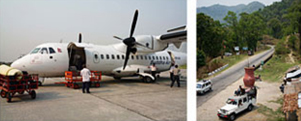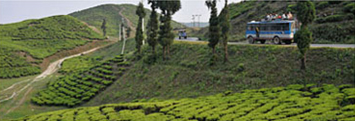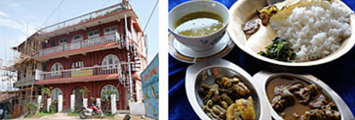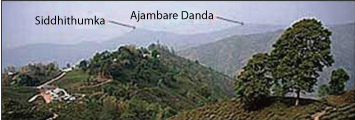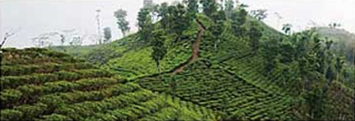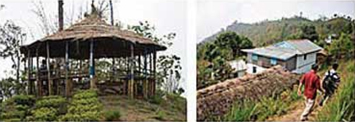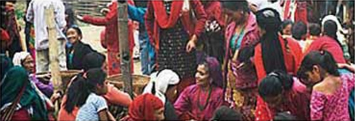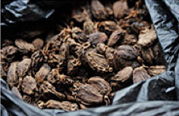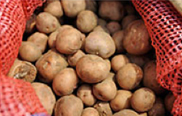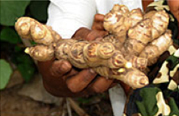| AJAMBARE PREMIUM TEA OF NEPAL |
| HOME | OUR STORY | PRODUCTS | SHOP | AGRITOURISM | CONTACT US | ||
|
|||||||||||
|
|||||||||||
|
Come and visit our gardens and experience the harvesting of tea or take a tour of the factory. Enjoy your morning brew from our freshly produced tea with its unforgettable taste. After several cups of tasty morning tea, you can spend time strolling around the tea gardens. This village at the foot of the Himalayas is known for its clean and invigorating air that feels as if it is washing out your inner body.
Take in the breathtaking view of Everest rising up into the sky to the north-west of the village. Or admire straight to the north the iconic hulk of Kanchenjunga, also known as the Goddess Mountain, and the third tallest peak in the world. Nepal is literally synonymous with trekking as it offers some of the most fascinating sceneries and the magic warmth of its friendly people. So, how about trying it out? You can take a short walk to the Ajambare Pass from where you can have a stunning view of the surrounding hills, the mountains beyond them and the verdant valleys with immaculate terraces bordering the villages that dot the landscape. On clear days, you can even see right down to the Terai plains towards the south. If you are in a mood for a slightly longer trek, the walk up to Siddhithumka will be rewarding in terms of the breathtaking view of the eastern Himalayan range. This is a popular view point in the region. We hope to attract foreign tourists to this marvelously beautiful land that offers stunning sceneries and unforgettable holidays. October and November are the best time for a visit. The entire eastern Himalayan range will be clearly visible and it is also the harvest season for the Autumnal flush tea. Our intention is to promote agritourism that will give a unique experience of village and farm life. We hope to provide visitors with an enchanting experience that will be quite different from the standard fare tourism. Being new to agritourism, our preparations are not fully complete and we are still learning the ropes. However, we intend to be ready by the year 2011, which is also the Nepal Tourism Year. Any advice or suggestion will be greatly appreciated and we encourage you to let us know how we can make the sojourns to our place a memorable one. |
|||||||||||
|
|||||||||||
|
The first leg of the journey is the flight from Kathmandu down to Bhadrapur in the south eastern corner of the country near the Indian border. Itfs a 50 minute flight on a turboprop aircraft. If you are lucky to get a left hand window seat and have a clear day, you will get a striking view of the Himalayan range as the plane will be flying almost parallel to it before veering off to the south east just before landing at Bhadrapur Airport. From Bhadrapur, itfs a 3 hours drive to Ilam Bazaar. After leaving Bhadrapur, you will drive a short distance north to Birtamode on the Mahendra Highway (also known as the East-West Highway), then a short drive east on this highway until you reach Charali. From there, you will turn north on the Mechi Highway driving through some tea plantations that produce CTC tea. In a while, the road will begin to climb up through the hills. On this winding mountainous road, there are some good spots for taking photos at the tea gardens of Kanyam, which lie on the crest of a hill. Fikkal Bazaar, also on the way, is a rest point for local buses and is famous for its vegetable momos (dumplings).
|
|||||||||||
|
|||||||||||
|
|||||||||||
|
|||||||||||
|
This is an old trading town. It is also where cultivation and production of tea was first started in Nepal. One can still see here the oldest tea garden of the country and also the remains of a factory. The town is situated on hilly terrain at a height of 1,208 m above sea level. The tea garden is surrounded by the town with its colorful buildings that dot the hillsides. Some wooden houses with tasteful balconies or bay windows can still be found standing around the town recalling the prosperous bygone times when the town was an important stopover point on the trading route between India and Tibet. There are many stagecoach buses that connect the town to outlying villages.
|
|||||||||||
|
|||||||||||
|
|||||||||||
|
This is the village of Ajambare Tea Association and it is situated at a height of 1,100 m above sea level. The mists rising up from the valley over the tea gardens which face the Himalayan range are apt symbols of a tea growing community. Most of the Association members are Buddhists and they put gLundalh, a charm flag, in front of their house.
|
|||||||||||
|
|||||||||||
|
Harvesting and Production of Tea
We recommend that you try out picking of tea leaves in the garden and then observe their processing at the factory. The red building surrounded by a verdant tea garden spread out over the rolling hills is the Mist Valley Tea factory. You can taste the tea and look around the factory under the personal guidance of Mr. Suresh Limbu, the owner. |
|||||||||||
|
|||||||||||
|
Trekking
We have a couple of trekking courses on offer. The first is a short trek to Ajambare Danda through the tea gardens. From this vantage point, you can see almost the entire gardens of the Jitpur village. The trek to Siddhithumka, which is at a height of 1,600 m above sea level, is longer and will take 5 hours of walk from the village. This is a popular point for viewing the eastern Himalayan range. On the way up there, you will pass through quaint hamlets with friendly villagers and well tended terraced fields. The route winds up and down several hills through forests and past grazing livestock before the final and short steep climb to the top. |
|||||||||||
|
|||||||||||
|
|||||||||||
|
|||||||||||
|
|||||||||||
|
Ilam is one of the eastern most districts of Nepal and is rich in biodiversity. In addition to tea, it is also well known for five other natural products whose names in the Nepalese language all begin with an gAh and are collectively called the gsix A of Illamh. They are:
|
|||||||||||
|
gALAICHIh cardamom
These are planted almost everywhere and even on the side of the road. They have small seed pod, triangular in cross-section and spindle-shaped. The outer shell is papery thin with small black seeds inside. The green pods of the plant are dried and the seeds inside the pod are used ? either in whole or ground form - in the Nepalese cuisine. Ground cardamom is an important ingredient in Nepalese food specially curries and is the primary contributor to the flavor of gmasala chah, spiced tea. In Nepal, tea is called gchah and, in India, its gchaih. |
|||||||||||
|
|||||||||||
|
gAKABAREha kind of chilly which is round in shape
This too is a sought after ingredient of the Nepalese cuisine. It is characterized by its very hot taste similar to gPhrickkinuh of Thailand. |
|||||||||||
|
|||||||||||
|
gAALUh potato
Itfs an indispensable vegetable of the Nepalese cuisine. Among other things, It is also used to make the famous gsamosah (picture on the right) that go so well with milk tea. |
|||||||||||
|
|||||||||||
|
gADUAh ginger
This is another important component of the gmasala chah. The ginger plants are covered with hay to protect them from the cold. This is a very vital cash crop for the farmers and is grown with much care as you can see in the picture. |
|||||||||||
|
|||||||||||
|
gAOLANh milk
Ilam produces high grade milk. Processed products made from it are in great demand even as far away as in Kathmandu. Almost everyone in Ilam starts his or her day in the morning with a cup of milk. |
|||||||||||
|
|||||||||||
|
"AMLISO" Tiger grass (Thysanolaena latifolia)
This is a bamboo like perennial plant with clumps. It can grow up to 2m in height with leaves that can be up to 7cm in width. The flowers stems with minute spikes in large branched clusters are tied together and used as brooms. |
|||||||||||
|
|
|||||||||||
|
Copyright (C) 2009 AJAMBARE TEA All rights reserved
|
|||||||||||
